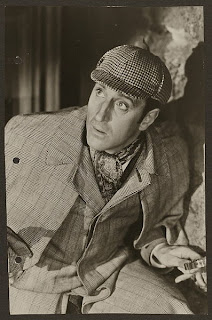In an effort to prepare myself for going back to school next month (eeeeeeek!), I've been trying to read and write as much as possible. Here's a little essay about Sherlock Holmes that I've been working on for ... well ... much longer than I would like to say. Enjoy!
****
The world is currently obsessed with Sherlock Holmes. He is
everywhere you look in popular culture, in various iterations—on television, on
film, in literature, in games.
But this fascination with the fabulous Baker Street boy and
his trusty companion John Watson is nothing new—the world’s love for the
detective has been steady and strong since he made his first appearance on the
world stage in 1887, when Arthur Conan Doyle’s first Sherlock novel, A Study in Scarlet, was serialized in
Beeton’s Christmas Annual.
Sherlock Holmes by Sidney Paget
Sherlock has been a mainstay in popular culture during times
when people have only wanted newness and modernity in regards to everything
else. The Guinness Book of World Records says that Sherlock Holmes is the most
portrayed movie character of all time, with 75 actors taking on the role in
over 200 films. Every decade since he first appeared has seen at least one new
version of—on the stage, on telly, on film or on paper.
Basil Rathbone as Sherlock Holmes. Rathbone portrayed Holmes in 14 films made during 1939-1946.
In just the last three years, the world has seen a
multi-million-dollar big screen franchise adaptation, a hugely popular British
television mini-series, an American television series (which has become the
most successful new show in 2012-13), a series of graphic novels for children,
a video game, and a new novel commissioned by Arthur Conan Doyle’s estate. Each
of these iterations stays relatively true to the original work—and why
shouldn’t they? Sherlock the First has all the sass, smarts and sensitivity
anyone could ever need.
On the other hand, a rose by any other name smells just as
sweet—and Sherlock Holmes transformed into new characters remains just as
affable, intriguing and popular. I firmly believe that every crime television
show—and possibly every crime film, too—is just Sherlock Holmes reiterated.
Even as he masquerades under other names, they all stem back to Holmes himself,
the original detective on the popular culture family tree.
Modern-day Sherlock: Shawn Spencer (left, played by James Roday) and Burton Guster, a.k.a. "Gus" (Dulé Hill, right) team up as a 21st-century Holmes & Watson on Psych.
I myself watch several iterations of the Sherlock story—both
the BBC series Sherlock and the Sherlock Holmes film franchise are some
of my favorites. I also love pseudo-Sherlocks, with Bones, The Mentalist—even
Psych—among some of my “shows.” Each
of these series displays the classic characteristics Sherlock Holmes introduced
into the crime genre.
To begin with, the protagonists are all elevated above the
average person (including the audience) in some way. In Bones, Temperance Brennan has an intelligence level much higher
than usual, which allows her to solve murder mysteries logically week after
week. In The Mentalist, Patrick Jane
has an acute attention to detail and a special ability to read people, allowing
him to constantly stay several steps ahead of his colleagues at the CBI—which
he gleefully enjoys. In Psych, Shawn
Spencer uses his photographic memory to trick the SBPD into believing he has
psychic powers; while those powers may be figments of his imagination, that
doesn’t stop him from putting away the bad guys by using his real skills.
Each of these shows also employs its own Watson, a “straight
man” who stands in for the audience as someone who doesn’t share Sherlock’s
abilities but still manages to become close to the detective—oftentimes as his
singular friend. In Bones, The Mentalist and Psych, the “Watsons”—respectively, Seely Booth, Theresa Lisbon and
Burton Guster (a.k.a. Gus, or Ghee Buttersnaps)—help solve the mysteries by
picking up clues along the way, but they are never able to figure out the final
problem, seeing as they lack Sherlock’s abilities.
The Mentalist's Patrick Jane is confronted by his very own Moriarty, Red John—whose true identity is yet to be revealed.
Finally, new iterations of Sherlock Holmes always feature
their very own Moriarty, the detective’s mortal nemesis—and only true
intellectual equal. Having an antagonist who not only rivals but measures up to
Sherlock humanizes the special detective while also emphasizing how impressive
his abilities are. The Mentalist has
interwoven Red John as its villain since its pilot episode, while Psych and Bones have switched out several Moriarties throughout the seasons.
However, even if the audience gets nervous for its Sherlocks, it never loses
faith that they will eventually win out in the end. He can, and he will. Every
single time.
Benedict Cumberbatch can solve any crime by dinnertime in the BBC series Sherlock.
To say the very least, Arthur Conan Doyle’s detective has
had an indelible affect on not only international popular culture, but in our
very lives—and there is no end in sight to Sherlock’s impact. Despite being
entirely fictional, we have entrusted him with very real issues, and we have
honored him as a true intellectual genius. And though we may not ever fully understand
him, we will always trust him—to be quirky, to be smarter than us, to keep us
safe and to always, always be waiting
somewhere for his next case.





Lovely post, Elizabeth!
ReplyDeleteWe can't forget the Great Mouse Detective. Classic. :)